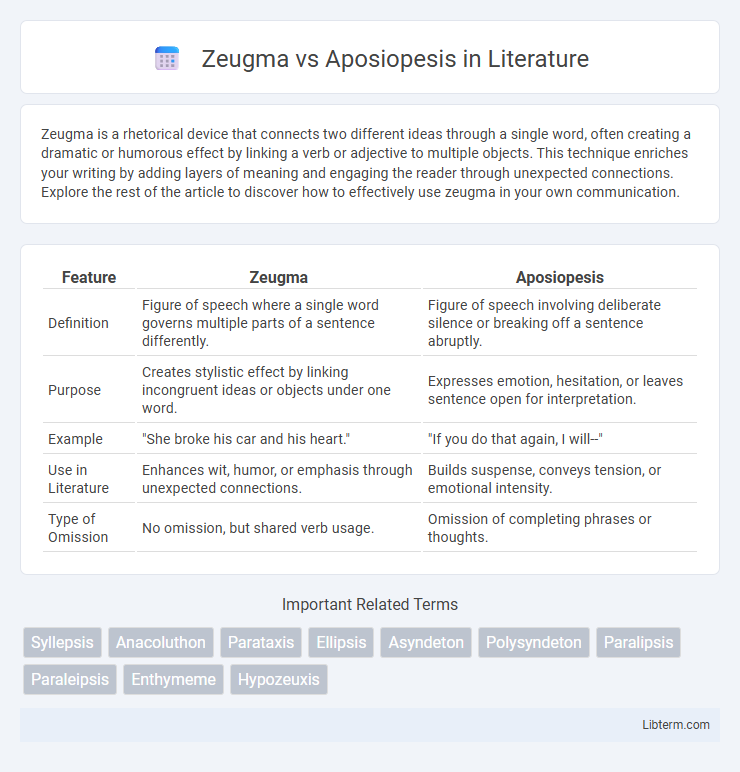Zeugma is a rhetorical device that connects two different ideas through a single word, often creating a dramatic or humorous effect by linking a verb or adjective to multiple objects. This technique enriches your writing by adding layers of meaning and engaging the reader through unexpected connections. Explore the rest of the article to discover how to effectively use zeugma in your own communication.
Table of Comparison
| Feature | Zeugma | Aposiopesis |
|---|---|---|
| Definition | Figure of speech where a single word governs multiple parts of a sentence differently. | Figure of speech involving deliberate silence or breaking off a sentence abruptly. |
| Purpose | Creates stylistic effect by linking incongruent ideas or objects under one word. | Expresses emotion, hesitation, or leaves sentence open for interpretation. |
| Example | "She broke his car and his heart." | "If you do that again, I will--" |
| Use in Literature | Enhances wit, humor, or emphasis through unexpected connections. | Builds suspense, conveys tension, or emotional intensity. |
| Type of Omission | No omission, but shared verb usage. | Omission of completing phrases or thoughts. |
Introduction to Rhetorical Devices
Zeugma is a rhetorical device where a single word, usually a verb or adjective, governs two or more words, though the word applies differently to each, creating a striking and often humorous effect. Aposiopesis involves deliberately breaking off a sentence and leaving it unfinished, evoking an emotional response or implying that the speaker is too overwhelmed or unwilling to continue. Both devices enhance expressiveness in language, with zeugma blending ideas through single-word control and aposiopesis using silence and implied meaning to engage the audience's imagination.
Defining Zeugma
Zeugma is a rhetorical device where a single word, typically a verb or adjective, governs or modifies two or more words in a sentence, often producing a surprising or humorous effect by linking disparate ideas. It creates economy of expression and highlights the relationship between the connected elements, such as in the phrase "She broke his car and his heart." Aposiopesis, in contrast, involves deliberately breaking off a sentence and leaving it unfinished, indicating an emotional or rhetorical interruption.
Understanding Aposiopesis
Aposiopesis is a rhetorical device where a sentence is deliberately broken off and left unfinished, creating a dramatic pause that implies strong emotion or hesitation. Unlike zeugma, which connects multiple elements with a single word, aposiopesis relies on the audience's imagination to complete the thought, intensifying the impact. Recognizing aposiopesis in literature and speech enhances comprehension of characters' inner turmoil and unspoken tension.
Key Differences Between Zeugma and Aposiopesis
Zeugma involves a single word, usually a verb or adjective, that governs two or more words in a sentence, creating a blend of literal and figurative meanings. Aposiopesis is a rhetorical device where a sentence is deliberately broken off and left unfinished, often signaling an emotional response or hesitation. Key differences lie in their functions: zeugma links elements with shared syntax to produce concise or witty effects, while aposiopesis interrupts thought to emphasize emotion or suspense.
Historical Origins and Usage
Zeugma originates from ancient Greek rhetoric, where it was used to link a single word to two or more others in different senses, enhancing stylistic effect and conciseness in classical literature. Aposiopesis, also rooted in Greek drama, features deliberate silence or breaking off mid-sentence to convey emotional intensity or dramatic tension, commonly utilized by playwrights like Sophocles and Seneca. Both devices shaped narrative and poetic techniques from antiquity through Renaissance literature, influencing modern linguistic expression.
Semantic Impact on Reader Perception
Zeugma creates a powerful semantic impact by linking two different ideas through a single word, prompting readers to interpret multiple meanings simultaneously, which enhances engagement and cognitive processing. Aposiopesis produces a dramatic effect by deliberately breaking off speech, inducing suspense and inviting readers to infer emotions or consequences beyond the text. Both rhetorical devices manipulate reader perception by either expanding interpretative possibilities with zeugma or invoking emotional depth and tension with aposiopesis.
Examples of Zeugma in Literature
Zeugma is a rhetorical device where a single word, usually a verb or adjective, governs two or more words, blending together grammatically and logically different ideas, as illustrated in Charles Dickens' example: "She broke his car and his heart." Another classic literary example occurs in Alexander Pope's line, "Here thou, great Anna! whom three realms obey, Dost sometimes counsel take--and sometimes tea," where "take" governs both "counsel" and "tea" creating a humorous effect. Unlike aposiopesis, which involves deliberate sentence breaks to express hesitation or emotion, zeugma showcases wit and conciseness by linking disparate objects under one verb.
Examples of Aposiopesis in Literature
Aposiopesis frequently appears in literature to convey intense emotion or hesitation, exemplified by Shakespeare's "King Lear" where Lear abruptly breaks off, saying, "I will have such revenges on you both...". Another notable instance is in Homer's "The Iliad," where characters often trail off mid-sentence to suggest overwhelming anger or fear, such as when Achilles stops abruptly, indicating his internal turmoil. These examples highlight aposiopesis as a powerful rhetorical device contrasting with Zeugma's linking of disparate ideas within a single phrase.
When to Use Zeugma or Aposiopesis
Use zeugma to create a stylistic effect by linking a single verb or adjective to multiple nouns, often to add humor or emphasize contrast within a sentence. Apply aposiopesis when conveying strong emotions or dramatic pauses, leaving a thought incomplete to engage the reader's imagination. Select zeugma for clarity and wit, while aposiopesis suits moments of tension or hesitation in dialogue or narrative.
Conclusion: Enhancing Expression with Rhetorical Devices
Zeugma and aposiopesis serve distinct rhetorical purposes that enhance expression by creating emphasis and engaging the audience's imagination. Zeugma links a single word to multiple parts of a sentence, often producing a witty or dramatic effect by combining different meanings. Aposiopesis, marked by a deliberate breaking off in speech, evokes emotion or suspense by allowing the listener to infer the unsaid, enriching the overall impact of communication.
Zeugma Infographic

 libterm.com
libterm.com